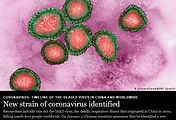중국인민일보, 2003년 사스(중증 급성 호흡기 증후) 코로나 바이러스를 발견한 중난산(钟南山) 박사 견해를 실었다. 중난산 박사는 1936년생으로 흉부질환 권위자임.
(중국 인민 일보 기사 요약)
1) 2020년 신종 코로나 바이러스 향후 전개 : 앞으로 7일~10일 까지 최고 고비를 맞이할 것이다. 그 이후 진정될 수 있다.
지금 가장 최선 방법은 두 가지인데, '조기 발견'과 '조기 격리 조치'이다.
2) 2003년 사스는 6개월 이상 지속되었으나, 신종 코로나 바이러스는 그 정도 길지는 않을 것이다.
3) 신종 코로나 바이러스에 대한 백신 개발은 앞으로 3~4개월 걸릴 예정
4) 2020년 신종 코로나 바이러스는 2017년 박쥐에서 발견된 바이러스와 상동 (相同 homology)를 띠고 있다.
그리고 신종 코로나 바이러스( the 2019-nCoV )는 야생동물로 추정되는 제 2 (중간단계) 호스트를 거쳐 형성되었다.
5) 환자 현황: 중국 30개 지역에서 신종 코로나 바이러스로 인한 폐렴 환자 숫자는 4515명, 이 중 106명 사망.
6) 우한 시에 현재 긴급 임시 병원을 건설한 목적은, 병원 안에서 감염을 막기 위한 것이다.
중난산 박사는 전국민이 협력해서 우한 시를 지원해야 한다고 제안했다.
기사 출처:
http://en.people.cn/n3/2020/0129/c90000-9652302.html
Novel coronavirus outbreak may reach peak in one week or about 10 days: expert
(Xinhua) 09:55, January 29, 2020
The novel coronavirus (2019-nCoV) outbreak may reach its peak in one week or around 10 days, renowned Chinese respiratory expert Zhong Nanshan said Tuesday.
By the end of Monday, 4,515 confirmed cases of pneumonia caused by the novel coronavirus had been reported in 30 provincial-level regions. A total of 106 people had died of the disease, according to the National Health Commission.
GUANGZHOU, Jan. 28 -- The novel coronavirus (2019-nCoV) outbreak may reach its peak in one week or around 10 days, renowned Chinese respiratory expert Zhong Nanshan said Tuesday in an exclusive interview with Xinhua.
"It is very difficult to definitely estimate when the outbreak reaches its peak. But I think in one week or about 10 days, it will reach the climax and then there will be no large-scale increases," Zhong said.
Zhong is the head of a national team of experts set up for the control and prevention of the novel coronavirus-caused pneumonia and an academician of the Chinese Academy of Engineering.
Renowned Chinese respiratory scientist Zhong Nanshan (钟南山)receives an interview with Xinhua in Guangzhou, south China's Guangdong Province, Jan. 28, 2020. (Xinhua/Liu Dawei)
"There are two keys to tackling the epidemic: early detection and early isolation. They are the most primitive and most effective methods," he said.
Zhong said fever and weakness are the typical symptoms of the novel coronavirus infection for the majority of patients.
Ten to 14 days is a sound period for isolation and observation: When the incubation period ends, those who fall sick will get timely treatment and those who do not will be just fine.
He suggested that hospitals should be staffed with not only infectious disease specialists, but also specialists in treating severe cases to better save patients.
By the end of Monday, 4,515 confirmed cases of pneumonia caused by the novel coronavirus had been reported in 30 provincial-level regions. A total of 106 people had died of the disease, according to the National Health Commission.
Aerial photo taken on Jan. 28, 2020 shows the construction site of Huoshenshan Hospital in Wuhan, central China's Hubei Province. The construction of Huoshenshan Hospital, a makeshift hospital for treating patients infected with the novel coronavirus, is underway in Wuhan. (Xinhua/Xiao Yijiu)
Among the total, Hubei Province in central China reported a total of 2,714 confirmed cases of the pneumonia caused by the virus. Wuhan, the provincial capital, is the center of the outbreak.
Epidemiologically, the novel coronavirus is homologous to the virus discovered in a type of bat in 2017, said Zhong, adding that the 2019-nCoV probably has an intermediate host that may be a certain kind of wild animal.
"The SARS (Severe Acute Respiratory Syndrome) outbreak lasted about six months, but I don't believe the novel coronavirus outbreak would last that long," said Zhong.
The country has taken a series of powerful measures, especially early detection and early isolation. "We have sufficient confidence in preventing a major outbreak or a recurrence as long as the two measures are in place, although we still need to conduct much scientific research," he said.
Noting that a key for Wuhan is how to reduce infections inside hospitals, Zhong said he supported the construction of makeshift hospitals in the city to control the infectious disease.
Members of a medical team heading for Wuhan of Hubei Province board the plane in Xining, northwest China's Qinghai Province, Jan. 28, 2020. A team comprised of 135 medical workers from Qinghai left for Wuhan on Tuesday to aid the novel coronavirus control efforts there. (Xinhua/Zhang Long)
Zhong said the activation of top-level public health emergency response was aimed at reducing the chance of infection.
The vaccine development may need three to four months or even longer, said Zhong. "Now scientists are speeding up research of neutralizing antibodies of the virus, but it takes time."
"With help from across the country, Wuhan, a heroic city, will pull through," Zhong said.
(Reporting by Wang Pan, Xiao Sisi, Li Laifang, Lou Chen, Cui Enhui)
'정책비교 > 의료' 카테고리의 다른 글
| 전 세계 코로나바이러스 감염자 수, 사망자 수, 통계 AP 중국 2592명, 한국 7명, 이란 8명, 프랑스 1명 사망자 외 (0) | 2020.02.24 |
|---|---|
| 신종 코로나 바이러스 조기 경보를 울린 리원량의 사망, 안타까운 죽음을 추모합니다. (0) | 2020.02.07 |
| 신종 코로나 바이러스, WHO 발표, 18개 국가 98 사례, 사망자 0 명 (0) | 2020.01.31 |
| 베이징에 20년 이상 거주한 독일 기자가 본 중국과 코로나 바이러스 위기.2002 사스때와 달라, 신속하게 협력중 (0) | 2020.01.30 |
| 비료공장 노동자 5명, 장점마을 주민 22명 암으로 사망, 그 책임은? 국민연금 , KT&G, 금강농산, 도시자 시장 무책임 동맹. (0) | 2019.11.14 |
| 삼성 반도체 직업병 인정 이후 과제, 건강 해치는 화학물질에 대한 노동자의 알 권리 (0) | 2018.11.27 |
| 2015년 담배 가격 인상, 현재의 담배 조세는 그 부담이 소득이 낮은 집단에 상대적으로 더 과중되는 역진적 성격 (0) | 2018.11.24 |





